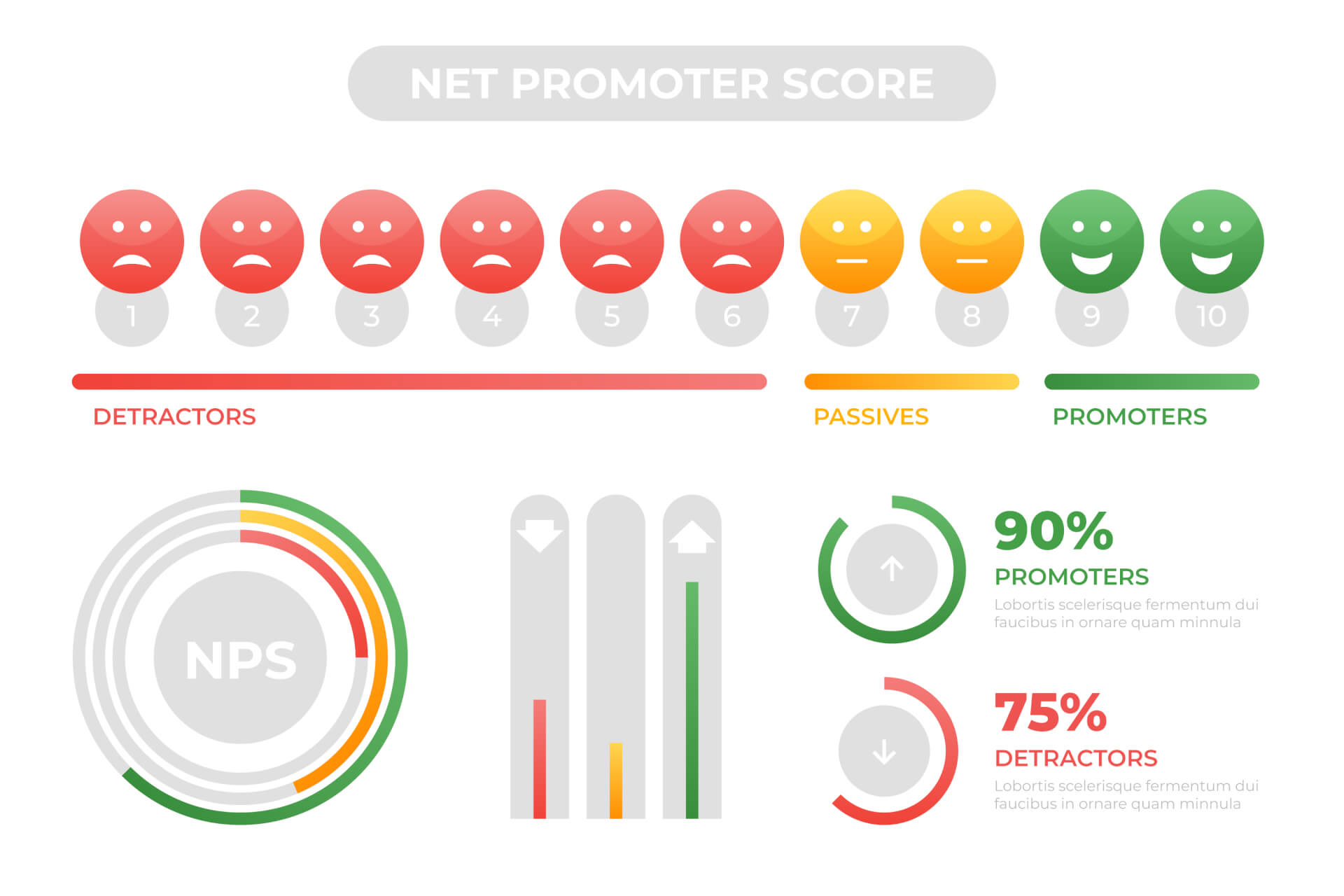 While many people consider Net Promoter Score® surveys to be a simple rating scale from 0 to 10, in reality NPS® has two sides - the quantitative (the rating) and the qualitative (the feedback) side.
While many people consider Net Promoter Score® surveys to be a simple rating scale from 0 to 10, in reality NPS® has two sides - the quantitative (the rating) and the qualitative (the feedback) side.
Just as an unanswered email is frustrating for the average user, there are few things that discourage a customer satisfaction professional more than an NPS survey that was only given a rating but no qualitative feedback.
Qualitative feedback, or text feedback, is part of what makes NPS such an effective strategy for measuring customer satisfaction. It provides additional insight so that you can react directly to the customer's feedback instead of just getting their opinion.
Even so, qualitative feedback is lacking in the vast majority of NPS survey data, which means that many organizations are suboptimally using NPS. While an effective NPS survey can achieve a response rate of 40%, many of these responses are purely quantitative and do not contain useful user feedback.
Sounds familiar? If you are one of the many people who use NPS software like Callexa Feedback to hear your customers' voices, there are a number of reasons why you may not get as many text responses as you want.
Table of Contents
Your customers are not used to personalized communication
 Unless you email your customers very often, receiving a Net Promoter Score survey can be a bit of a surprise.
Unless you email your customers very often, receiving a Net Promoter Score survey can be a bit of a surprise.
As a result, many customers may be willing to take a minute or two to rate your business or product but will not leave a message. The reason? Since you've rarely contacted them, there's no human on the other side of the conversation to visualize. The reference is missing.
Building a personal connection with your customers, be it via email or live chat, can go a long way in improving not only the qualitative feedback you get from your NPS surveys, but also your overall response rate.
To make your emails more personal, add a short message to your NPS survey explaining why you are reaching out and how much you would care for a response. Send the email from a real, human email address - not a generic "no-reply" address.
For example, would you feel motivated to spend a few minutes of your time composing a detailed reply to an email without the message being sent by a real person? As you personalize your NPS survey, you will quickly find that the number of qualitative responses you get increases.
Your customers are nervous about giving honest feedback
 Sometimes your customers may be willing to give an accurate rating in the course of the survey and, if they are promoters, recommend your company to friends and acquaintances. But you don't get honest feedback.
Sometimes your customers may be willing to give an accurate rating in the course of the survey and, if they are promoters, recommend your company to friends and acquaintances. But you don't get honest feedback.
What is the reason for this? These customers may be in frequent contact with people at your company, but they may feel uncomfortable giving honest feedback if it means that they may be offending someone.
This is a common problem that small and medium-sized businesses struggle with when surveying their customers using the NPS. The problem is also widespread among service companies, where a complaint submitted via email can be read by the person responsible for the problem. This problem also arises in the B2B world, as one seldom wants to be seen as impolite or abusive towards an important supplier. Fortunately, the problem in this area often resolves on its own once a closer relationship has been established.
If not, there are several ways to deal with this problem. The first is to explain to customers that you value any positive or negative feedback. Let them know that you enjoy reading direct and clear feedback, especially criticism and notes on bugs.
The second option is to reach customers through an alternative medium - a tactic that we will discuss in more detail later in the text.
Your customers want to talk to you, but not by email
 This reason for not getting quality feedback is shaped by the circumstances outlined above - your customers want to speak, but may not be comfortable having to provide honest feedback via email.
This reason for not getting quality feedback is shaped by the circumstances outlined above - your customers want to speak, but may not be comfortable having to provide honest feedback via email.
Sometimes the most effective way to get honest and actionable feedback from your customers is to reach out to them the old-fashioned way: over the phone.
If you've received an NPS survey response from a customer who makes it clear they're not completely satisfied but doesn't provide the details in text form, then get in touch directly with a phone call. Instead of the silence that exists over the medium of e-mail, there is a good chance that he will quickly tell you the reason for his dissatisfaction.
A contact over the telephone is a particularly effective strategy for connecting with critics in the B2B industry. In most cases, a simple phone call is enough to show that you value your relationship and want to check that everything is okay.
After you've successfully contacted a passive or a critic over the phone (or any medium other than email, such as speaking at a venue or visiting the office in person), keep the next answer to the NPS survey in mind, it will be significantly more positive than the last few surveys.
Your customers are too new to provide useful feedback
 Some customers might want to complete your survey, but feel too "fresh" to provide useful advice to your business. This usually means getting an accurate score on your NPS survey, but little actionable feedback.
Some customers might want to complete your survey, but feel too "fresh" to provide useful advice to your business. This usually means getting an accurate score on your NPS survey, but little actionable feedback.
This happens quite often, especially with new SaaS startups without an established base of users and paying customers. When a customer is first using your product, their focus is often more on getting around and setting things up than helping you improve.
New customers can't leave feedback for the opposite reason: They signed up because of a mismatch between expectations and reality and then left as soon as they discovered that your product didn't meet the expectations.
Similar to other problems, there are several ways to deal with this. The first is to personalize your onboarding process (e.g. with a personal "welcome on board" email) to make it clear to new customers that they are never more than a step away from talking to actual people are.
In the age of chatbots and automated help desks, you will be surprised how effective a simple personalized email can be.
The second option is to send an email asking for quick and easy feedback after receiving the NPS rating. Often, a short and gracious email from a customer success manager is enough to open and close the customer feedback loop with a new customer.
Your customers are tired of receiving NPS emails
Like all communication methods, NPS email can become bothersome and ineffective if used excessively
Some companies get addicted to NPS easily, treating it as a metric that can never be high enough. While it is good for any business to focus on continuous improvement, sending email after email is not the right way to do it.
If you send too many NPS surveys, you will find that your response rate drops or your customers leave a review quickly without leaving any feedback. The end result is less reliable data and a less effective customer satisfaction survey process - two things you definitely don't want.
Unfortunately, this problem is so common that it should be added to your list of Bad NPS Practices that it is best to avoid. While it's good to keep in touch with your customer and close the customer feedback loop when you get feedback, no company scores as a spammer.
Callexa Feedback has appropriate mechanisms that always ensure that your customers are not asked too often, that your response rate remains high and that you receive qualitative feedback.
We have sparked your interest in NPS surveys with Callexa Feedback
and you would like to start collecting qualitative feedback about your company?
Then register your permanently free "Starter" tariff today or make an appointment for a demo.
We are looking forward to talking to you!
 Reading recommendation: If this article helped you and you would like to find out more about the Net Promoter Score, continue reading here: “The Net Promoter Score – Basics and Areas of Application”
Reading recommendation: If this article helped you and you would like to find out more about the Net Promoter Score, continue reading here: “The Net Promoter Score – Basics and Areas of Application”